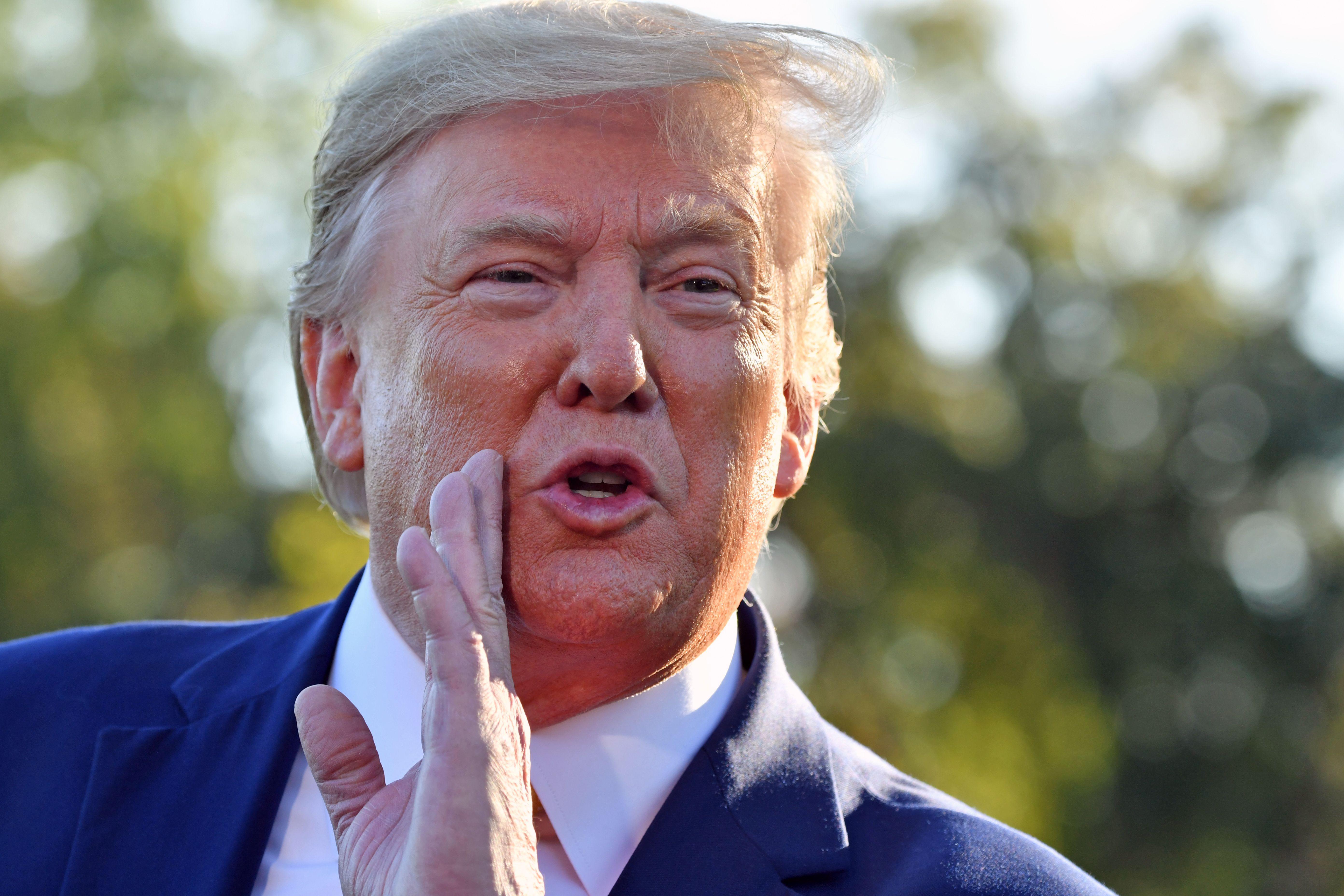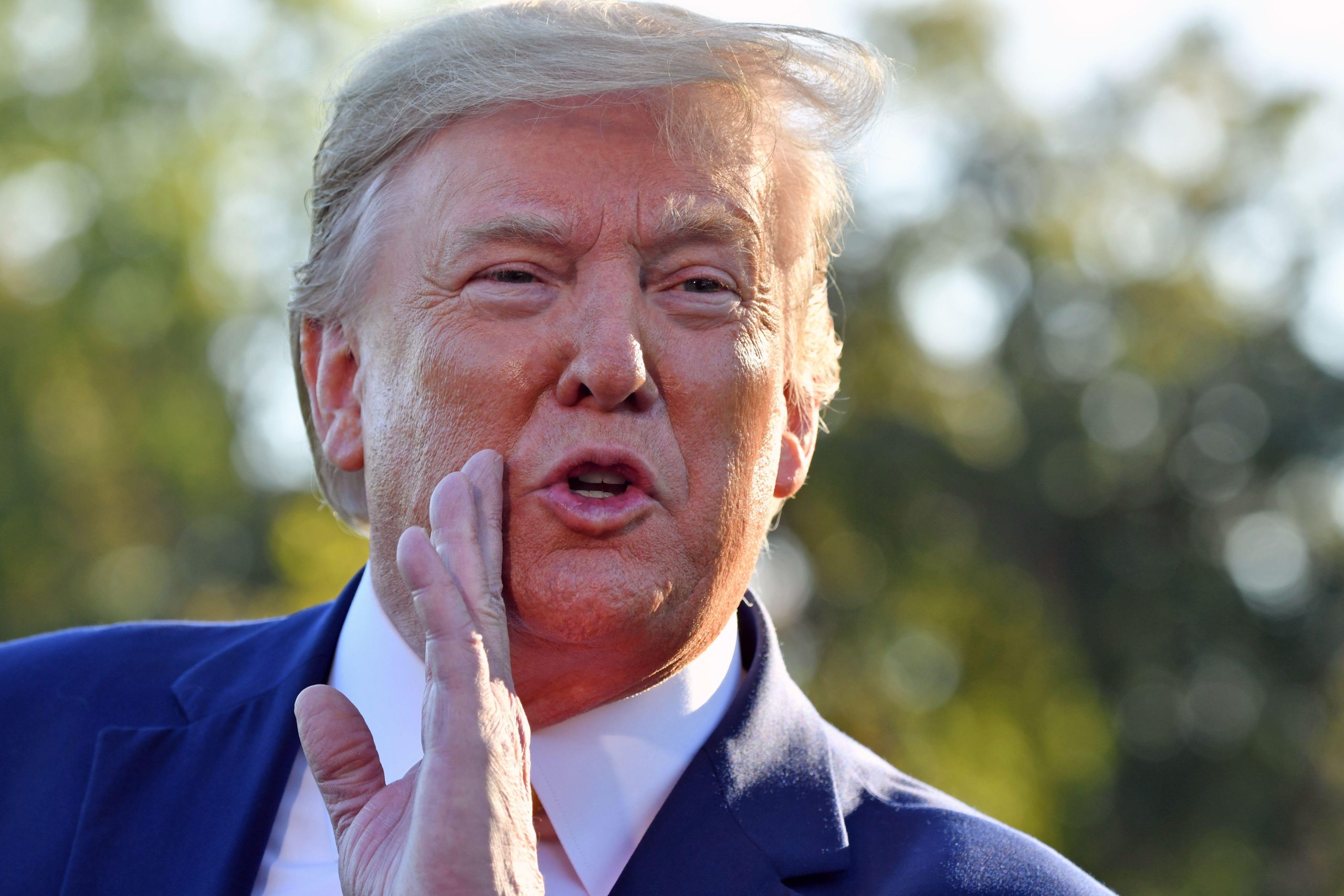
Donald Trump speaks to the press at the South Lawn of the White House in Washington, DC October 11, 2019. (Photo by Nicholas Kamm / AFP) (Photo by NICHOLAS KAMM/AFP via Getty Images)
AFP via Getty Images
Tiffany & Co. has delayed its departure from Donald Trump’s 6 East 57th Street in New York City, a property the jewelry company has occupied for the last few years while it renovates its flagship Fifth-Avenue location next door. The move has allowed Trump to maintain a glitzy retailer in his building at a time when both ecommerce and the coronavirus have made it challenging to fill big storefronts.
Trump’s history with Tiffany dates back more than a half century. “From the time I took an apartment in Manhattan in 1971 and began walking the streets, the site that excited me the most was the eleven-story building at 57th Street and Fifth Avenue that housed Bonwit Teller,” Trump wrote in The Art of the Deal, referencing a department store next to Tiffany’s. Trump started referring to the Bonwit Teller space as the “Tiffany location.” He ended up building a tower at the site, which he claimed he considered calling Tiffany Tower. But, as Trump tells the story, a friend encouraged him to use his own name instead, so it became Trump Tower.
Constructing Trump Tower was no easy feat. Through a series of deals, the real estate developer cobbled together the parcel, partnering with the Equitable Life Assurance Society to get control of the land, buying air rights above Tiffany to make the building taller, then pressuring a man named Leonard Kandell to give him an 100-year lease on neighboring 6 East 57th Street that allowed Trump to enlarge the footprint. Tiffany held onto the corner lot on 57th Street and Fifth Avenue, but Trump took control of the parcels surrounding it, boxing in the jeweler with Trump Tower, which opened in 1983, on its southern side and 6 East 57th Street on its eastern wall.
The flagship store for Tiffany & Co., currently undergoing renovations, rests at the corner of Fifth Avenue and 57th Street in New York City, surrounded by Trump buildings. Trump Tower stands to its right while 6 East 57th Street sits on its left.
LightRocket via Getty Images
In 1995, Trump welcomed Nike to 6 East 57th Street. Around the same time, Trump borrowed $93 million against the building, agreeing to pay 7.125% interest until 2017. Despite the interest payments, it proved to be a good deal for Trump. Nike’s lease had been set to expire around 2010, but the documents allowed the shoe company to renew for an additional five years. Nike stayed in the building and extended its lease again in 2015, the year Trump announced his candidacy for president, paying an estimated $16 million annually.
Then things got complicated. After Trump won the election in 2016, Trump Tower turned into a fortress, with media outlets camped out downstairs, capturing a parade of people going up the elevators to meet with the president-elect. The hoopla was not good for the neighborhood. Tiffany told investors that its holiday sales dropped 14% that year, in part due to “postelection traffic disruptions.” At least the Trumps were still buying—they famously arrived at the White House on inauguration day with a Tiffany-blue box to hand the Obamas.
The presidency stirred up additional tensions on the block. Nike had been a big supporter of the Trans-Pacific Partnership, a trade pact negotiated under Obama. Trump withdrew from it almost immediately. Then, in September 2017, the former president jumped into the controversy over kneeling NFL players, musing with a crowd in Alabama: “Wouldn’t you love to see one of these NFL owners, when somebody disrespects our flag, to say, ‘Get that son of a —– off the field right now. Out! He’s fired.” Nike sided with the kneelers, featuring quarterback Colin Kaepernick in its marketing efforts, something the former president described as “a terrible message.” In a 2018 interview with the Daily Caller, Trump stopped short of demanding Nike change its decision. “Nike is a tenant of mine,” he explained. “They pay a lot of rent.”
A shopper exits Nike’s old Niketown store at 6 East 57th Street on March 18, 2015. Photographer: Victor J. Blue/Bloomberg
© 2015 Bloomberg Finance LP
In fact, Nike had just moved out of 6 East 57th Street, leaving early to relocate a few blocks south to 650 Fifth Avenue. Two Nike employees told Forbes at the time that politics played a small role in motivating the move, but they said the bigger driver was the floorplan of 6 East 57th Street, a vertical building with a massive hole in the middle of it. For a time, Nike continued to provide rent, which it helped to cover by subleasing its space to Tiffany. That offered some saving grace for Trump, allowing him to avoid an embarrassing vacancy.
It also worked well for Tiffany, which secured a place to relocate while it renovated its building next door. In 2019, signs for the jeweler appeared in the big, arched window on the façade of Trump’s 6 East 57th Street. The Tiffany website made it clear that the move was just temporary, inviting customers to visit 6 East 57th Street “until the reinvention is completed in late 2021.”
Gradually, that date shifted. By September 2020, the website explained that the work would be done “in spring 2022.” By October of last year, the date had moved again, this time to “fall 2022.” Last month, a security guard posted outside of the Tiffany-owned store said the jeweler would be moving out of Trump’s building in mid-November. Nike’s lease expired at some point between 2018 and today, but Tiffany, Nike and the Trump Organization would not confirm exactly when. The jeweler has stayed in the building, suggesting Tiffany is now paying rent directly to the Trump Organization.
At a minimum, Trump should get about an extra year of occupancy from Tiffany. The former president, or his underlings at the Trump Organization, are almost certainly searching for a replacement retailer right now. There’s a chance they have already found someone but just haven’t announced it yet. Any company moving in will have to be okay with being associated with Trump, whose business did not respond to requests for comment. If the former president fails to find a new tenant, he’ll be left with roughly 65,000 empty square feet—a big black eye just around the corner from Trump Tower.







